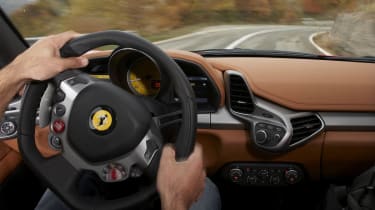Ferrari 458 (2009-2015): review, specs and buying guide
Few supercars have aged so gracefully; the 458 remains thrilling, engaging and deeply desirable today
Sold as Ferrari’s final naturally-aspirated mid-engined V8 model, the 458 is undoubtedly a future classic. Of course, the ultra-focused Speciale is the ultimate, and remains one of the finest driver’s cars of all time, but the standard 458 Italia is still an outstanding supercar. At its launch in 2009, it offered a generational leap in performance and technology over its F430 predecessor, and its Pininfarina design has stood the test of time beautifully.
Powered by a sensational 9000rpm 4.5-litre V8 (codenamed F136), 562bhp and 398lb ft of torque are sent to the rear axle for a 3.4sec 0-62mph time – faster than the four-wheel drive Lamborghini Gallardo of the time. Not only is it potent in a straight line, but the 458 offers some of the finest dynamics of any mid-engine supercar – that it posted a quicker lap time than the track-honed 430 Scuderia around Fiorano is all the proof you need.
One of the 458’s most notable new features was its seven-speed dual-clutch transmission. Developed by German firm Getrag as its very first DCT, the Powershift 7DCL750 was a groundbreaking piece of engineering, offering almost zero latency between shifts (sub-50 milliseconds) – the same unit has since been used in the Mercedes-AMG SLS and even the V6-powered Ford GT, in some form or another.
More reviews
Despite the svelte bodywork and a lack of obvious wings and splitters, the 458 generates up to 360kg of downforce – thanks in part to trick winglets in the front air intakes that drop by 20mm at speed. Included in the car's advanced suite of electronics was a cutting-edge e-diff and F1-Trac stability control, but despite its inherent complexity, few major issues have emerged since the 458 emerged nearly 15 years ago, making it an attractive used buy...
Engine
The flat-plane V8 shows an impressive reliability record and is wholly issue free. Hefty service bills are kept at bay due to the absence of cambelts, too. Locating the source of electronic niggles can be somewhat of a goosechase, so make sure you attend a diagnostics-equipped workshop to identify any electronic foibles. This explains why the majority of 458s remain in dealer circles and – while values remain steady – are likely to continue to do so for the foreseeable future.
In 2011, Ferrari introduced the seven-year service programme, it wasn’t void by change of ownership, so look for nothing less than a full Ferrari service history. 458s built prior to 2011 won’t be covered under warranty – even the extended warranty plan ran-out after five years.
Transmission
The twin-clutch unit is Getrag-built, it’s a revised version of the item found in the Ferrari California but with shorter gearing and recalibrated shifts. Like the powerplant, it’s proving sturdy and largely problem-free. A few owners have flagged-up clutch glitches, a simple fix, resetting the clutch-positioning sensors and updating the software. You can check how much is left in the clutch, and it’s certainly worth the trouble seeing as a new clutch kit will leave you £20k poorer.
Suspension, Steering, Brakes
The standard adaptive dampers are around £1500 apiece and are only purchasable in pairs, so check for any leaks – this is not usually covered under the warranty. The area most likely to deal a big dent to your finances is the brakes. A set of front pads alone is about £700, and if the discs are gone it’s £10k for a new set. So check they’ve been tested for wear and condition. The 458 is also quick to chew through its tyres so a fresh set is a bonus (rears are £250 apiece). Cast an eye over the wheels and look for damage (inside and out), a new one is £2500.
Body, interior, electronics
Bodywork corrosion isn't a major issue (although some owners have reported issues around the rear arches), so you’re looking for evidence of accident damage, such as variable panel gaps, over-spray and blend-in lines. Get under the lip spoiler and check for scrapes, as well as any scuffs and paint chips around the nose.
Test all the gadgets to see they function to purpose – TFT screens have been known to cause problems on occasion. When new, a number of 458s caught fire – the perpetrating rear-arch liners should have been replaced.
What to pay
A budget of £115,000 is enough to secure a clean 458 Italia at the time of writing. If that sounds like strong money, it’s worth remembering that most examples cost their first owner in the region of £200,000 with options. Well kept, highly original 458s with around 20,000 miles tend to command £135,000, with drop-top Spider versions starting from £140,000. The Speciale’s halo status brings with it an astronomical price: don’t expect much change out of £250,000.
What we said
‘It’s clear within the first few miles that Ferrari’s decision to use a double-clutch gearbox was the correct one. Less than 50 milliseconds after you flick either paddle, the gear engages. The real advantage is at low speed – you can dawdle in the 458 with no clunking actuators and no rancid clutch smell.
‘Heading up into the hills, the roads are wet and the surface cratered with poor repairs – not a place you’d normally want to be in a 562bhp Ferrari – but the 458 is about as tame as this type of vehicle can be under such circumstances. Its electronic chassis armoury is now impregnable – F1-Trac melds with E-Diff3 to create an acronym orgy of unparalleled dynamic brilliance.
‘The 458 also sets new standards of straight-line performance in this class. It pulls convincingly from 2000rpm and builds so strongly in the mid-range that by the time you’re waiting for the final, frenzied attack on the rev-limiter you’re left a little disappointed that you don’t sustain some manner of neck injury. The 458 continues what must be the finest patch of road-car form Ferrari has ever enjoyed.’ – evo 139
'I bought one'
‘As regular evo readers will know, my car was bought primarily to run on 6th Gear’s supercar driving experience events, although in the early days I also used it for my regular commute between the office in Tamworth and home just north of Sheffield.
‘We got off to a shaky start when a faulty fuel sender left the car stranded on the hard shoulder of the M1. I also found the on-board computer unnecessarily complicated, and didn’t get on with the wheel-mounted indicator buttons. But as the months went by I couldn’t help marvelling at the car’s range of talents. Here was a Ferrari that in auto mode my mum could literally drive to the shops, and the very next day it could be hammering around Castle Combe.
‘There have been a few electronic glitches and recurring warning lights, mostly relating to the traction control. But the only major issue was when it developed a serious-sounding rattle from the top of the engine at around 60,000 miles. When Graypaul Ferrari investigated, they found significant camshaft damage. Fortunately, Ferrari UK agreed to authorise a repair under warranty.
‘In nearly six years, it’s covered around 80,000 miles – more than half of those on track and with literally thousands of different drivers. Remarkably, it’s lost none of its pace and, what’s more, the classic magnolia interior is virtually unmarked and the interior rattle-free. Its maintenance records over the last couple of years show it’s nipping at 6th Gear’s Audi R8 V10s in terms of reliability. It’s certainly head and shoulders above the F430 we used to run, which quickly exhibited signs of fatigue after sustained track use.
‘The 458 has confirmed my belief that modern Italian supercars benefit from mileage – there’s no need to fear putting big miles on a 458, except of course for the accelerated depreciation. It’s just a shame more owners don’t really drive and enjoy them.’ – Simon George
Ferrari 458 Italia specs
| Engine | 4.5-litre naturally-aspirated V8 |
| Power | 562bhp @ 9000rpm |
| Torque | 398lb ft @ 6000rpm |
| Weight | 1485kg |
| Power-to-weight | 378bhp/ton |
| 0-62mph | 3.4sec |
| Top speed | 202mph |
| Price new | £169,545 |
| Value today | From £115,000 |







